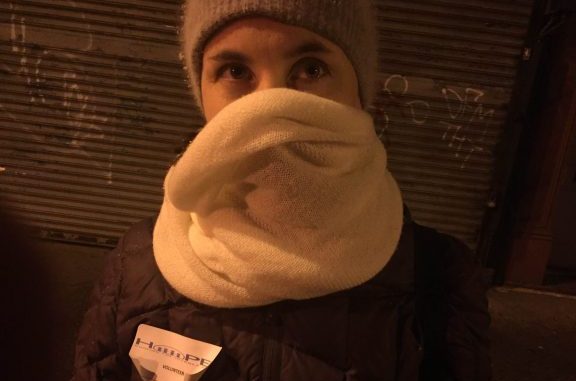Blog

HOPE2016: A Cold Night Out With a Mission
February 11, 2016Thousands of volunteers dispersed throughout New York City this past Monday night in the city’s annual Homeless Outreach Population Estimate (HOPE) count. A total of 20 people represented CUCS, including Moira Flavin, our Manager of Institutional Giving. We sat down with Moira to learn more about the HOPE count and her experience canvassing the streets of Brooklyn for the second time during one of the coldest nights of the year.
What is the purpose of the HOPE count?
The HOPE count is a way of estimating the population of chronically street homeless people in New York City. It’s done in the winter, in the middle of the night, to get a sense of who is really chronically homeless. We were told not to count people in public spaces like ATM vestibules or restaurants so we focused on people who were literally on the street between midnight and four in the morning.
Where were you assigned?
I was in downtown Brooklyn. Around 75 to 100 of us were gathered in an elementary school cafeteria where we were split up in teams of 3. There was a district captain – a Department of Homeless Services employee – at the site and each team was given a couple of maps of survey areas to cover. We were also given training on Code Blue procedures and told that we should wake up anyone who was sleeping and check that they were ok.
How big was the area you canvassed?
According to my teammate’s Fitbit, we walked 4 miles. It was a very residential area that stretched between Fort Greene and Clinton Hill so there were very few people out. However, we were told to stop everyone we encountered, excluding those who were obviously working, since we can’t assume that someone is or isn’t homeless.
Were you able to provide any services?
As the organizers stated, the purpose of HOPE count is not to offer services but to get a population count. If someone did want services, we were certainly going to connect them, especially during a Code Blue. There was a van driver at every site ready to pick up anyone who asked for help. If people refused services, we gave out cards with where to go for help if they changed their minds.
Having done this for two consecutive years, what was the difference between last year and this year?
Last year was absolutely freezing. It was very cold and I had a different, larger survey area and was out until almost four in the morning. I was so uncomfortable and I remember thinking ‘I don’t need to do this again. I experienced it once, I think that’s enough.’ And then there was a switch in my brain that said ‘this is a temporary thing and there are people out here who have no other choice and the city has to do this in order to get the federal funding it needs.’ This year was cold and it did start to snow around one in the morning but it was not as frigid. My survey area was also smaller and we managed to finish earlier than last year so that was better.
Why do you participate?
It’s an important thing to do and experience, if only for a couple of hours, what it’s like to be out on the street in the middle of the night with no place to go. You’re temporarily uncomfortable while you’re out surveying people who are potentially out there for long periods of time, and you get a real perspective after going back to a warm apartment. I will never take my housing for granted again. Particularly in my role, because I don’t do direct services, I think it’s important because it brings me closer to the work. It’s also nice to meet the other volunteers. They work in a variety of settings but they are all passionate about ending homelessness.
